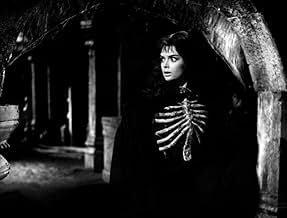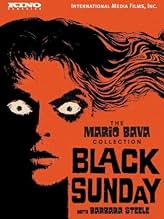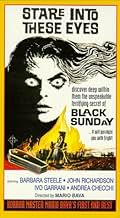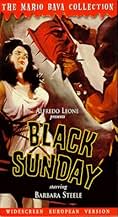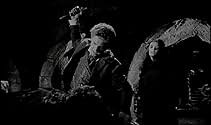IMDb-BEWERTUNG
7,1/10
19.057
IHRE BEWERTUNG
Eine Hexe und ihr Diener kehren aus dem Grab zurück und beginnen einen blutigen Feldzug, um den Leichnam des wunderschönen, ihr ähnlich sehenden Nachkommen der Hexe in Besitz zu nehmen.Eine Hexe und ihr Diener kehren aus dem Grab zurück und beginnen einen blutigen Feldzug, um den Leichnam des wunderschönen, ihr ähnlich sehenden Nachkommen der Hexe in Besitz zu nehmen.Eine Hexe und ihr Diener kehren aus dem Grab zurück und beginnen einen blutigen Feldzug, um den Leichnam des wunderschönen, ihr ähnlich sehenden Nachkommen der Hexe in Besitz zu nehmen.
- Auszeichnungen
- 1 Gewinn & 1 Nominierung insgesamt
Barbara Steele
- Princess Asa Vajda
- (as Barbara Steel)
- …
Giuseppe Addobbati
- Priest
- (Nicht genannt)
Fernando Cajati
- Crucifixion Torturer
- (Nicht genannt)
Valentina Cortese
- Tavern Girl
- (Nicht genannt)
Angelo Galassi
- Tavern Keeper
- (Nicht genannt)
Nando Gazzolo
- Narrator
- (Synchronisation)
- (Nicht genannt)
Renato Montalbano
- Spectator
- (Nicht genannt)
Empfohlene Bewertungen
Be sure and watch the uncut version with the title "The Mask of Satan," not the censored "Black Sunday" copy, to get the full effect of this living dead masterpiece of Italian cinema. More a movie of the undead than a vampire flick, it reminds the horror aficionado of a Val Lewton film from the 1940's, especially "The Leopard Man," not that "The Mask of Satan" is about leopards, but the mood and atmosphere are similar.
The film is about a woman of darkness and her mate who were executed for witchcraft two centuries before the Napoleonic period of European history. The most gruesome feature of the execution involved nailing a mask of Satan to their faces by means of a giant sledgehammer before they were entombed. By accident two hundred years later a doctor and his assistant while journeying through the region by coach on a dark stormy night filled with eerie devilish sounds, the doctor removes the mask from Princess Asa Vajda supposed corpse. Now Princess Vajda and her fiendish companion become free to seek their revenge. Their evil is released on the world and must be stopped.
This is undoubtedly director Mario Bava best film. The marvelous camera work draws the viewer into the maelstrom of darkness and evil through innovative movements and angles. The shadowy settings where the actors are posed in ominous fashion are unforgettable. One obvious inspiration for Bava was the contemporary British Hammer horror film popular in America, especially with the drive-in crowd. The arrival of Katia Vajda with what appear to be the dogs of Hell, standing like a silhouette of damnation, reminds one of a Caspar David Friedrich painting from the German Romantic art movement of the Napoleonic era. One wonders if the director of "The Omen," Richard Donner, patterned his creepy scene in the cemetery with the Rottweilers after this scene in "The Mask of Satan."
This movie remains a must see for horror fans, somewhat of a lost treasure.
The film is about a woman of darkness and her mate who were executed for witchcraft two centuries before the Napoleonic period of European history. The most gruesome feature of the execution involved nailing a mask of Satan to their faces by means of a giant sledgehammer before they were entombed. By accident two hundred years later a doctor and his assistant while journeying through the region by coach on a dark stormy night filled with eerie devilish sounds, the doctor removes the mask from Princess Asa Vajda supposed corpse. Now Princess Vajda and her fiendish companion become free to seek their revenge. Their evil is released on the world and must be stopped.
This is undoubtedly director Mario Bava best film. The marvelous camera work draws the viewer into the maelstrom of darkness and evil through innovative movements and angles. The shadowy settings where the actors are posed in ominous fashion are unforgettable. One obvious inspiration for Bava was the contemporary British Hammer horror film popular in America, especially with the drive-in crowd. The arrival of Katia Vajda with what appear to be the dogs of Hell, standing like a silhouette of damnation, reminds one of a Caspar David Friedrich painting from the German Romantic art movement of the Napoleonic era. One wonders if the director of "The Omen," Richard Donner, patterned his creepy scene in the cemetery with the Rottweilers after this scene in "The Mask of Satan."
This movie remains a must see for horror fans, somewhat of a lost treasure.
For some unknown reason, here recently I've been in the mood to watch a lot of vintage 1960s-70s Italian horror movies. Hardly any other film comes as highly recommended as Black Sunday and after viewing this incredibly moody effort, I can easily see why. It's by far one of the most beautifully photographed films I've seen of any genre. It's also one of the most atmospheric; a sense of horror and dread hang over every frame, and yet it is a film whose power does not lie entirely in the narrative. It's hidden somewhere, pretty much everywhere... in dark corners, in secret crypts, in fog, in shadows... The shots in this film are brilliantly composed. It is a true triumph for director and cinematographer Mario Bava, who provides such rich, dream-like technical depth that (pardon the cliché) this film truly does transport viewers somewhere else in time.
Even though this movie is best appreciated as an exercise in style and technique, the plot line (witch who is executed and returns centuries later to get revenge on the descendants of her executioners) is also enjoyable. So is Barbara Steele, who is ideally cast in a dual role as both the evil witch and the pure heroine. She's an actress who can switch from innocent and ravishing to hideous and horrific with the flick of an eyelash. No wonder she's considered the queen of horror. She deserves to be.
Even though this movie is best appreciated as an exercise in style and technique, the plot line (witch who is executed and returns centuries later to get revenge on the descendants of her executioners) is also enjoyable. So is Barbara Steele, who is ideally cast in a dual role as both the evil witch and the pure heroine. She's an actress who can switch from innocent and ravishing to hideous and horrific with the flick of an eyelash. No wonder she's considered the queen of horror. She deserves to be.
BLACK Sunday (Mario Bava - Italy 1960).
Mario Bava's first feature as a director (although he did uncredited directorial work before), this classic and extremely influential piece of Gothic horror really showed his cinematographic talent in creating a haunting and stylishly shot film. "Black Sunday" also catapulted Barbara Steele to horror stardom and would make her into the undisputed horror queen of the sixties. Bava based "Mask of Satan", as the film was originally titled, on the short story "Vij" by the Russian author Gogol, which he adapted into a homage to the early Universal horror pictures he loved so much. Barbara Steele is the beautiful 17th century witch princess Asa, who is a vampire, and her lover Juvato (Arturo Dominici), are put to death by her vengeful brother. He has iron masks with spikes on the inside placed on both their faces and then sledgehammered home (the brutal opening scene). Two hundred years later, blood is accidentally spilled on Asa's face and she rises from the dead along with Juvato to wreak revenge on the descendants of those who executed her - including her look-alike Katia, also played by Barbara Steele.
Beautifully shot in black and white by Bava himself, "Black Sunday" is a perfect showcase of his masterful control of light and shade, of colour and movement (yes, one can play with "shades of colour" in black and white) and playful camera angles, it's a feast for the eye. At heart Bava would always remain the cinematographer he always was and in all his films he took an active role in the design of each image by setting up the lighting, the optical effects, the filters etc. The film abounds in old-fashioned horror atmosphere and in that department, it even manages to top the atmosphere of the Universal horror classics it was based on with gnarled tree branches, fogbound sets, a decaying castle, a dark foreboding crypt and much more.
Of course, Bava's is well known for letting stylistic innovations take precedent over storytelling and most other things involved, like acting. Much of the script was reworked during shooting and even in post-production. Barbara Steele reportedly never even saw a script and got some pages every day of shooting. Variations of the story has been told many times in one way or another and there are more than a few echoes of Murnau's Nosferatu here. Much of the story is too derivative to begin with, and has become too formularised in subsequent years to retain much of its original power, just as the film's capacity to scare or excite audiences has probably worn out a little over the years. It doesn't really matter, because the film was chopped to pieces for over four decades and the habit of Italian filmmakers of post-synchronizing all the voices (even for Italian versions) made anything in that department a pretty dire affair anyway.
What Bava added however was some substantially more explicit violence and gore, laced with sexual connotations. The opening scene in which the mask is sledgehammered to Barbara Steele's face still packs quite a wallop, not to mention the effect it must have had on audiences back then. Still, horror fans can't really afford to miss this quintessential Bava piece, but watch it for the splendid cinematography and Bava's unique ways of visual wizardry.
Camera Obscura --- 7/10
Mario Bava's first feature as a director (although he did uncredited directorial work before), this classic and extremely influential piece of Gothic horror really showed his cinematographic talent in creating a haunting and stylishly shot film. "Black Sunday" also catapulted Barbara Steele to horror stardom and would make her into the undisputed horror queen of the sixties. Bava based "Mask of Satan", as the film was originally titled, on the short story "Vij" by the Russian author Gogol, which he adapted into a homage to the early Universal horror pictures he loved so much. Barbara Steele is the beautiful 17th century witch princess Asa, who is a vampire, and her lover Juvato (Arturo Dominici), are put to death by her vengeful brother. He has iron masks with spikes on the inside placed on both their faces and then sledgehammered home (the brutal opening scene). Two hundred years later, blood is accidentally spilled on Asa's face and she rises from the dead along with Juvato to wreak revenge on the descendants of those who executed her - including her look-alike Katia, also played by Barbara Steele.
Beautifully shot in black and white by Bava himself, "Black Sunday" is a perfect showcase of his masterful control of light and shade, of colour and movement (yes, one can play with "shades of colour" in black and white) and playful camera angles, it's a feast for the eye. At heart Bava would always remain the cinematographer he always was and in all his films he took an active role in the design of each image by setting up the lighting, the optical effects, the filters etc. The film abounds in old-fashioned horror atmosphere and in that department, it even manages to top the atmosphere of the Universal horror classics it was based on with gnarled tree branches, fogbound sets, a decaying castle, a dark foreboding crypt and much more.
Of course, Bava's is well known for letting stylistic innovations take precedent over storytelling and most other things involved, like acting. Much of the script was reworked during shooting and even in post-production. Barbara Steele reportedly never even saw a script and got some pages every day of shooting. Variations of the story has been told many times in one way or another and there are more than a few echoes of Murnau's Nosferatu here. Much of the story is too derivative to begin with, and has become too formularised in subsequent years to retain much of its original power, just as the film's capacity to scare or excite audiences has probably worn out a little over the years. It doesn't really matter, because the film was chopped to pieces for over four decades and the habit of Italian filmmakers of post-synchronizing all the voices (even for Italian versions) made anything in that department a pretty dire affair anyway.
What Bava added however was some substantially more explicit violence and gore, laced with sexual connotations. The opening scene in which the mask is sledgehammered to Barbara Steele's face still packs quite a wallop, not to mention the effect it must have had on audiences back then. Still, horror fans can't really afford to miss this quintessential Bava piece, but watch it for the splendid cinematography and Bava's unique ways of visual wizardry.
Camera Obscura --- 7/10
BARBARA STEELE became an icon of horror films (the way Christopher Lee did when he played Dracula), when she played the role of a vampire witch princess burned at the stake in the 17th century who returns two hundred years later with a vengeance. Not that the story itself is all that original, but when done as stylishly as it is here, with the perfect B&W atmosphere and chiller mood, it's a winner.
There's no let-up in suspense from the gripping opening scene where the mask of Satan is nailed onto the face of the poor victimized woman, even though the unfolding of the story is rather slow. The graveyard scene of an undead man rising from the earth is masterfully photographed. The mood becomes more and more intense as several key characters emerge as vampires.
As a young doctor who figures importantly in the plot, JOHN RICHARDSON is a rather wooden actor and makes a cardboard hero, but in a film that relies on its effect for brilliant camera-work and Gothic touches, it's not much of a flaw. Barbara Steele's impassive mask-like beauty is suitable in the eerie dual role she plays with wide-eyed conviction.
The moody camera-work captures the spirit of Gothic horror in every shadowy scene. While the story itself is less than inspired, it does fulfill the promise of a good cobweb chiller right up until the rather predictable ending.
Well worth watching for fans of this genre.
There's no let-up in suspense from the gripping opening scene where the mask of Satan is nailed onto the face of the poor victimized woman, even though the unfolding of the story is rather slow. The graveyard scene of an undead man rising from the earth is masterfully photographed. The mood becomes more and more intense as several key characters emerge as vampires.
As a young doctor who figures importantly in the plot, JOHN RICHARDSON is a rather wooden actor and makes a cardboard hero, but in a film that relies on its effect for brilliant camera-work and Gothic touches, it's not much of a flaw. Barbara Steele's impassive mask-like beauty is suitable in the eerie dual role she plays with wide-eyed conviction.
The moody camera-work captures the spirit of Gothic horror in every shadowy scene. While the story itself is less than inspired, it does fulfill the promise of a good cobweb chiller right up until the rather predictable ending.
Well worth watching for fans of this genre.
La Maschera Del Demonio/The Mask of Satan(1960) is the film that introduced audiences around the world to the cinema of Mario Bava. After years as Assistent Director and Director of Photography, Bava was rewarded with his first full directorial assignment and the results are impressive. He didn't direct full time until he was in his late 40's. Its interesting to note that two other directors named Lucio Fulci and Terence Fisher didn't get international recognization until their big breaks(Zombie[1979] + Curse of Frankenstein[1957]) when they were in their early to mid 50's. Its about a dead witch who returns from the dead with her lover to terrorize the descendents of their executioners. It was done due to the success of Horror of Dracula(1958).
The opening scene of the execution of Asa is a stunning combination of atmosphere and violent imagery. The Mask of Satan(1960) is based on a short story by Nikolai Gogol. Gogol is a writer that would play together with Edgar Allen Poe as a major influence in Bava's Supernatural tales. Its one of the best horror films of the last fifty years. Asa is resurrected when the blood of a doctor is accidently dropped on her corpse(this is played homage to in Lamberto Bava's Demons 2{1986}). Tim Burton has cited this movie as one of his favorites.
The film was pratically butchered in the states when first released, but has since been released on Home Video in uncut form(longest print in existence). This is an item that many aspiring Horror Filmmakers should watch in order to see how a great horror film should be done. The Mask of Satan(1960) isn't interested in plot and story as much as atmosphere and painting style visuals. Barbara Steele emerges as the first horror queen of the modern era. Barbara Steele has a macabre beauty that bewitches the viewer and gives her presence. Barbara Steele along with Christopher Lee, Peter Cushing, and Vincent Price were some of the greatest icons in 1960's-1970's horror films.
Barbara Steele does outstanding work as the witch Asa and her descendent Katia. Mario Bava's direction has the look of a great artist. Bava also contributes to the great cinematography. La Maschera Del Demonio is a well made mixture of the Universal Horror features of the 30's-40's and the violence of Hammer Horror of the 50's-60's. The fact that Mario Bava did this based on the success of Horror of Dracula(1958) must have influenced Terence Fisher to respond by directing Dracula:Prince of Darkness(1965). One theme that is present in The Mask of Satan(1960) is the decay and decline of a once happy and powerful family(more fully explored in Bava's later films of Black Sabbath{1963}, The Whip & the Body{1964}, Lisa and the Devil{1974}, and Shock{1977}).
The opening scene of the execution of Asa is a stunning combination of atmosphere and violent imagery. The Mask of Satan(1960) is based on a short story by Nikolai Gogol. Gogol is a writer that would play together with Edgar Allen Poe as a major influence in Bava's Supernatural tales. Its one of the best horror films of the last fifty years. Asa is resurrected when the blood of a doctor is accidently dropped on her corpse(this is played homage to in Lamberto Bava's Demons 2{1986}). Tim Burton has cited this movie as one of his favorites.
The film was pratically butchered in the states when first released, but has since been released on Home Video in uncut form(longest print in existence). This is an item that many aspiring Horror Filmmakers should watch in order to see how a great horror film should be done. The Mask of Satan(1960) isn't interested in plot and story as much as atmosphere and painting style visuals. Barbara Steele emerges as the first horror queen of the modern era. Barbara Steele has a macabre beauty that bewitches the viewer and gives her presence. Barbara Steele along with Christopher Lee, Peter Cushing, and Vincent Price were some of the greatest icons in 1960's-1970's horror films.
Barbara Steele does outstanding work as the witch Asa and her descendent Katia. Mario Bava's direction has the look of a great artist. Bava also contributes to the great cinematography. La Maschera Del Demonio is a well made mixture of the Universal Horror features of the 30's-40's and the violence of Hammer Horror of the 50's-60's. The fact that Mario Bava did this based on the success of Horror of Dracula(1958) must have influenced Terence Fisher to respond by directing Dracula:Prince of Darkness(1965). One theme that is present in The Mask of Satan(1960) is the decay and decline of a once happy and powerful family(more fully explored in Bava's later films of Black Sabbath{1963}, The Whip & the Body{1964}, Lisa and the Devil{1974}, and Shock{1977}).
Wusstest du schon
- WissenswertesMario Bava and Barbara Steele had a difficult working relationship. She sometimes refused to come to set because she did not like her wig or the fact that her cleavage would be shown. One time she refused because she believed Bava would force her to appear nude. She admits that she was difficult due to her inexperience and inability to understand Italian.
- PatzerIn the opening credits, Barbara Steele's name is misspelled as Barbara Steel.
- Zitate
Princess Asa Vajda: You, too, can feel the joy and happiness of hating.
- Crazy CreditsFor "The Mask of Satan," the English language version prepared in Italy, Barbara Steele's name is listed as "Barbara Steel" on the trailer and on the credits of the film itself.
- Alternative VersionenThe full list of differences between the 83-minute original cut and the 80-minute AIP cut:
- A different English-language dub, and a new score by Les Baxter.
- An added pre-text crawl warning the audience about the film's content: "The producers of the picture you are about to see feel a moral obligation to warn you that it will shock you as no other film ever has. Because it could be very harmful to young and impressionable minds, it is restricted to only those over fourteen years of age."
- Alternate opening credits.
- A brief exchange between Katja and Constantine where he tells her their father has died is cut.
- A scene where Katja and Andrej talk in the garden is cut.
- An exchange between Katja and Andrej outside her room is cut.
- Kruvajan's death scene is cut down significantly to remove shots of his eye spurting blood.
- The scene were Prince Vajda reanimates and menaces Katja is trimmed.
- Vajda's death scene, particularly the close-ups of his head melting, is trimmed.
- Asa taunting Andrej before being burned at the stake is cut.
- Added closing credits.
- VerbindungenFeatured in I motorizzati (1962)
Top-Auswahl
Melde dich zum Bewerten an und greife auf die Watchlist für personalisierte Empfehlungen zu.
Details
- Laufzeit1 Stunde 27 Minuten
- Farbe
- Sound-Mix
- Seitenverhältnis
- 1.66 : 1
Zu dieser Seite beitragen
Bearbeitung vorschlagen oder fehlenden Inhalt hinzufügen

Oberste Lücke
By what name was Die Stunde, wenn Dracula kommt (1960) officially released in India in English?
Antwort

